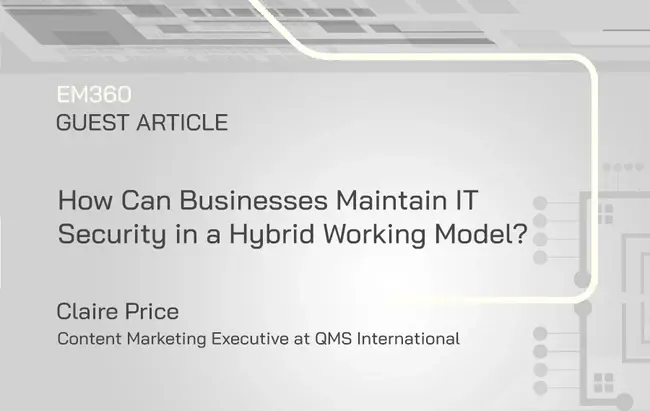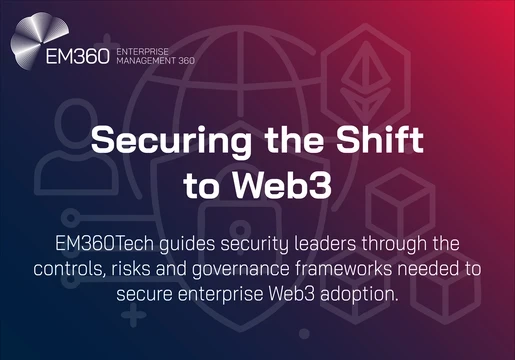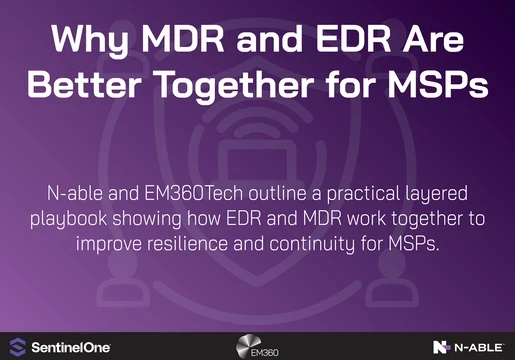This article was written by Clare Price, Content Marketing Executive at QMS International.
Businesses now have the green light to go back to work, but your organisation may not be returning to its old working practices. So, if a hybrid model is being adopted, what can you do to ensure that information stays secure?
The introduction of more widespread homeworking has certainly piled on the pressure for businesses’ IT security.
At the beginning of 2021, QMS International carried out a survey of businesses about their cyber security and 75.7% of the respondents reported that they now felt more open to attack. Another 10% reported that they had no confidence in fending one off.
And businesses have a right to be worried. According to analysis of reports made to the UK’s Information Commissioners Office (ICO) by CybSafe, the number of ransomware incidents in the first half of 2021 doubled compared to the number reported in the first half of 2020.
Malicious emails have also been redirected to attack those working from home. Data supplied by Darktrace to The Guardian revealed that the proportion of attacks targeting home workers rose from 12% of malicious email traffic before the first lockdown in March 2020 to more than 60% six weeks later. With homeworking becoming more of a permanent fixture in business models, this trend is likely to continue.
While hybrid working offers your team the best of both worlds when it comes to office and home working, it also leaves your business open to the unique risks associated with both, with the added bonus of those linked to transport and travel.
But this doesn’t mean you have to abandon this new way of working. With the right processes in place, you can ensure your information stays secure, no matter where your staff are based.

Carry out a risk assessment
First things first – you must carry out a risk assessment.
Knowing the precise risks your business faces is key to developing methods of removing or mitigating them, but assessments like this are often overlooked. In fact, QMS’ cyber report found that 30% of respondents admitted that no new information security risk assessments had been carried out, despite changes to working practices.
Discover the risks, analyse their likelihood, and then decide if and how they can be controlled. This will give you the grounding you need to build your wider hybrid IT strategy.
Train and test your team
With cyber-attacks on the rise and remote workers being more vulnerable, it’s crucial that your hybrid team know what to look for and, just as crucially, how to report anything suspicious. The best way to do this is through training, which can now be carried out very effectively via e-learning.
This training should cover common cyber-attacks - such as phishing emails - how to spot them, the fundamentals of social engineering, and how to report suspicious activity. Ideally, this training should be refreshed regularly as new cyber threats emerge. You may also like to include training on the safe use of video calls and how to ensure video cameras are switched off when not in use.
To ensure your team have absorbed what they’ve learnt, carry out testing. This involves crafting fake phishing emails and sending them out to your employees. What they do will give you an idea of whether your training has been effective.
Address access
When your hybrid team aren’t in the workplace, they will need to access servers and files remotely. This will often be via a VPN (Virtual Private Network), so you need to ensure that this is as secure as possible.
Remote workers will also be relying on their home Wi-Fi, but this may not be as secure as the Wi-Fi in your office. Your team should therefore be encouraged to create strong passwords – not the default ones on the base of the router.
Workers need to be cautioned against the use of free Wi-Fi hotspots too. It’s possible that your workers may want to use it to work on the train, for example, or in a coffee shop. However, public Wi-Fi is notoriously unsecure, and your workers should be cautioned against using it.
Think about physical protection
If your workers are going to be travelling between locations, then they are going to have to carry equipment such as laptops, phones and removable media with them. If something is lost or stolen, your business information could be compromised. Indeed, IBM’s Cost of a Data Breach report revealed that around 10% of malicious breaches are due to a physical security compromise.
A solid back-up protocol is key to ensuring that any lost information can be recovered. A robust password and access process are also musts – you may want to think about two-factor authentication to make logging in more secure. Make sure you also have a protocol in place so that if your team do report something as lost or stolen, you can act quickly.
When working remotely, you need to ensure that your staff keep their physical devices safe too. Equipment should be kept out of sight when not in use and papers stored away. If your workers are printing content, you may also need a safe disposal or destruction policy in place.
To prevent prying eyes seeing something they shouldn’t, workers should lock their screens when away from their workspace, whether they’re in the office or at home. And if any of your team do want to work while in public, they should be cautioned about the kind of work they perform – who knows who’s sitting next to you?
Create a culture of security
If you really want to know what information security practices will bring you to the next level, you may want to consider a more wide-reaching measure such as ISO 27001.
ISO 27001 is the international Standard for information security management, and it is designed to help organisations integrate information security into every aspect of business.
Its 114 controls tackle every angle of security, including physical, legal, digital and human, bringing them together to enable you to maintain compliance and showcase to employees, customers and stakeholders that you have the processes in place to protect information from theft and corruption.
Going forward, it could give you the framework you need to adapt your practices to suit your new hybrid working model and any changes in the future.
This article was written by Claire Price of QMS International, one of the UK’s leading ISO certification bodies.







Comments ( 0 )